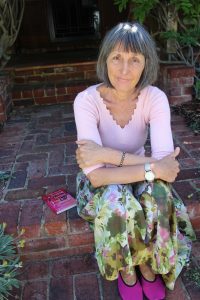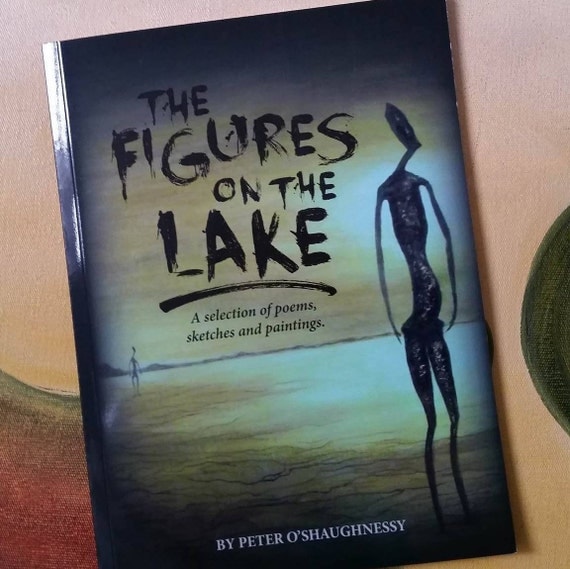It is a delight to welcome Brigid Lowry to Aussiereviews. 
If you’re struggling to maintain grace and good humour amidst daily potholes and pitfalls, Brigid may be just the warm, wise and witty companion you need. Her new book is called A Year of Loving Kindness to Myself and other essays.
Greetings. My name is Brigid Lowry.
I didn’t start out wanting to be a writer. I tried being a librarian, a schoolteacher, a waitress, a cook and a laboratory assistant, and had various other unmentionable jobs, then lived in a Buddhist community for many years, helping to raise children, run retreats and build adobe buildings. When I was 35, married with one son, I went back to university and realised that writing was the thing I loved to do.
My first title was a mushy teenage love story in the Dolly Fiction series. Various twists and turns led me to a rather lovely career writing for teenagers and teaching creative writing to people of all ages, though I still published poetry and short fiction here and there. My MA in Creative Writing involved writing a semi-autobiographical adult novel and an academic thesis on the topic of memoir. Most of my YA titles were fiction, but one was non-fiction – Juicy Writing: Inspiration and Techniques for Young Writers. Although it was marketed this way, many adult writers have told me they love this book and use it often for inspiration. More recently, I have returned to writing for adults and, in 2016, my first adult title, Still Life with Teapot: On Zen, Writing and Creativity, was published by Fremantle Press.
A Year of Loving Kindness to Myself and Other Essays is my latest book and it’s about to hit the shops. I’ve been practising meditation in the Zen and Vipassana traditions for 40 years, and during those years I have also explored personal growth and therapy to process the events of a challenging childhood. My work and themes have evolved from these sources. In my new book I offer insights and suggestions for anyone wishing to live a sane, nourishing and creative life in these difficult times, using humour to lighten the mood.
I am very much in favour of humour as good medicine. My favorite cartoonist is Roz Chast, who uses her own life and the lives of fellow New Yorkers in her wise, warm and excellent cartoons. I also love Anne Lamott, who is a recovered alcoholic, a Christian and one of the funniest writers I have encountered. She writes about her own neurosis and struggles, inspiring the reader by sharing her joys and triumphs. Life is good, but also weird and hard, she writes.
So, how do we navigate life’s challenges? Are our survival mechanisms healthy? Buddhist teacher and psychologist Josh Korda calls drinking a failed attempt at happiness, yet wine o’clock is common for many until health or financial issues become problematic, or one realises that the thrill is short-lived, that hangovers suck and that the problems you were trying to avoid did not magically vanish. Similarly, working too hard, emotional eating, recreational shopping or too much screen time are temporary fixes. A little may be good, too much proves hollow. In my own life, I have found creativity, meditation, exercise, the outdoors and human connection of benefit.
Reading and journalling are precious tools for creating a meaningful life. Savour books, keep a pile beside your bed, use them as islands of wonder. Read widely, read deeply, but skim if you need to. Give yourself permission to abandon a boring book. When feeling stale, make haste to the library or a bookshop, feasting on what you find there. Books provide an unlimited source of escape, fascination, knowledge and solace.
Journalling is a satisfying way of staying in touch with yourself and your feelings, a safe place to be yourself when the world seems murky. It can bring clarity in the midst of mayhem, comfort when one is world-weary. Choose a cheap exercise book or a fancy journal. Grab an old pencil or some rainbow pens. Collect ideas, memories, wise thoughts. Record your dreams. This life is so precious, so fleeting and so ready to be explored on paper in your own sweet way.
Try some lists. The five worst people to invite to dinner. The 10 things that bring merriment. The three best places to yell out loud. The six uses for a banana that are not eating it. The eight things you would like for your birthday that don’t cost any money.
Wishing you creativity and wonder, ease and delight.
 A Year of Loving Kindness to Myself and other Essays by Brigid Lowry is available in all good bookstores and online.
A Year of Loving Kindness to Myself and other Essays by Brigid Lowry is available in all good bookstores and online.
https://www.fremantlepress.com.au/products/a-year-of-loving-kindness-to-myself











